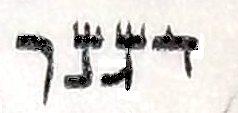Question: Does
the law of yud of the alef shin ayin etc. that are touching the body of the ois, straight
without a connecting oketz (SA 32:18), apply in gimel?
Note MS ois gimel
אם נדבק הירך בהרגל יגרור הירך ודי בכך
(if the left foot
is stuck to the right foot ..) – this can mean pic.1 because it is [like a]
nun, or also pic. 2?
pic. 1
It is accepted
here in Eretz Yisrael that there is a sfardi gimel that is written
m'lachatchila as pic.2, it is locali called "gimel Bagdadi" (the
gimel that Iraqi/Bagdad sofrim were custom to write), this is noted in Biur
Hasofer ibid. in the name of Da'as Kdoshim – that this gimel is csav velish. [Old
csav velish, but today all sofrim sfardim don’t write the gimel so, rather like an
ashkenazic gimel the left foot separated from the guf. Even sofrim from the
iraqi community today don't write a gimel as prescribed "gimel Bagdadi"].
Questions:
1) can there be a change hallachicaly, that a
gimel once accepted as kosher [even l'chatchila] is now pasul bdieved?
2) If the gimel was kosher for velish/bagdad
does that make it automaticaly kosher [bdieved] for ashknazim (then, or even
now)?
Bezras Hashem to
be continued next week.
Popular posts from this blog
Klaff Tanning question:
By
Rabbi Eli Gutnick
-
I received this question via email. I am not really a klaf expert, I was wondering if anyone could answer this question: Dear Rabbi Gutnick, I am writing to you because a good friend of mine has put the idea into my head that the klaf in my tefillin were not really tanned and therefore are not kosher. He referred me to Megilla 19a re diftera. From the research that I have done so far, it seems that the klaf that is used today is tanned only with a lime wash. On all of the tanning websites I’ve seen so far, they say that the lime doesn’t accomplish tanning but only the removal of the hair and some other pre-tanning effects. Would you be able to explain to me or refer me to a website that explains how the tanning process that is used today takes the hide out of the category of diftera? Thank you very much.
Rabbi Reuvain Mendlowitz clarifies his position on Ksav Chabad (and my final thoughts)
By
Rabbi Eli Gutnick
-
Last week I posted some thoughts in response to a public lecture given by Rabbi Reuvain Mendlowitz regarding Ksav Chabad (the Alter Rebbe's ksav). I felt he did not represent the issue fairly, and since I had received questions about it from a number of people I felt it made sense to write a general response. After I posted my response on this forum, Rabbi Mendlowitz reached out to me by email and we ended up having a respectful and productive email exchange regarding the relevant issues surrounding Ksav Chabad. His position is a lot clearer to me now, and I think he also took certain things on board that I clarified with him. The purpose of the Stam Forum (at least back in it's heyday before all the whats app groups took over) was to connect sofrim from around the world, to promote achdus and build bridges, as well as to offer support and advice. In that spirit, I felt I should write a follow up post, to clarify some of the issues and misconception...




Comments
Post a Comment